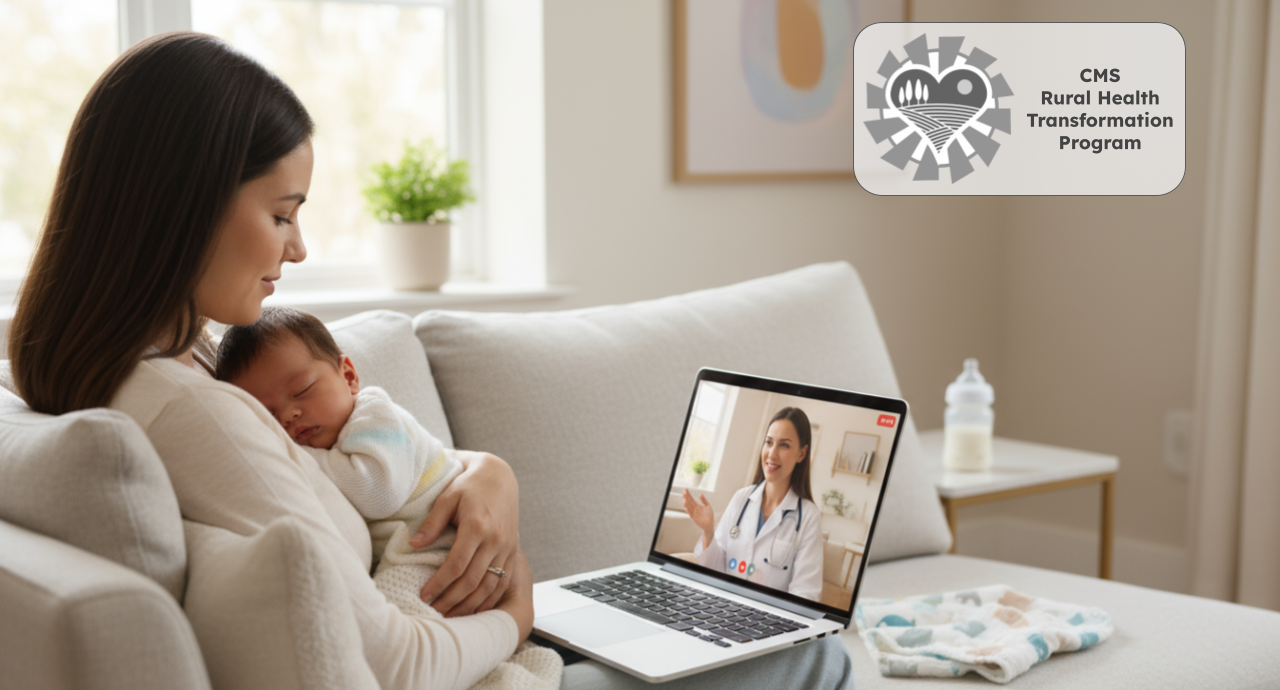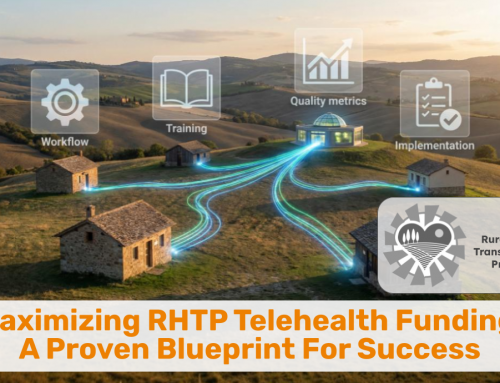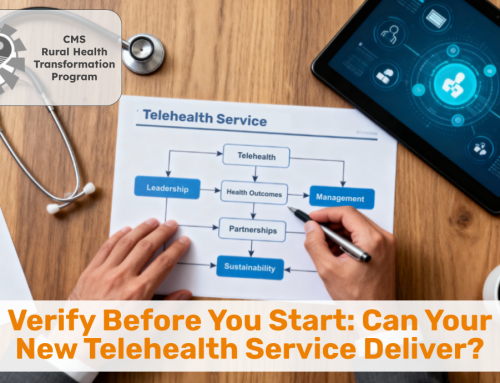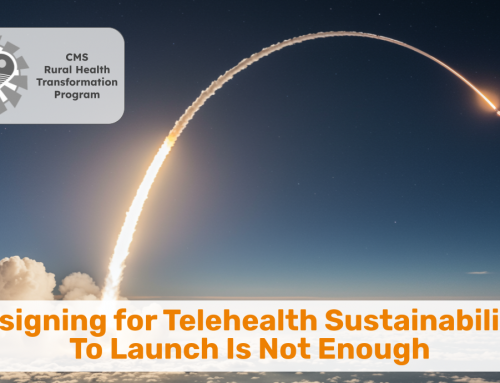Maternal care deserts are growing in rural America, leaving pregnant patients with few options, long travel times, and inconsistent access to essential services.
As of 2025, nearly half of U.S. counties now have no hospital-based obstetric services, and rural OB/GYN practices face growing pressure from workforce shortages, financial strain, and fragmentation of care. These challenges are especially acute during the perinatal period, when care coordination, behavioral health integration, and timely monitoring can significantly affect outcomes for both mother and baby.
Telehealth provides a practical, evidence-based strategy to close maternal care gaps across the full pregnancy-through-postpartum continuum. When implemented intentionally, it enables rural providers to deliver flexible, connected, and patient-centered care — while supporting workforce sustainability and data-informed quality improvement.
This article outlines three sets of proven telehealth solutions that rural organizations can implement across three critical care phases: prenatal care, labor and delivery, and postpartum care. Each is paired with implementation considerations and strategic value to help rural stakeholders translate intention into measurable outcomes.
9 Proven Telehealth Solutions for PRENATAL CARE
Expecting moms in rural areas often face long travel times, limited appointment availability, and fragmented specialty care during pregnancy. Telehealth allows providers to deliver timely prenatal monitoring, education, and collaboration — without requiring every encounter to be in person.
Even the American College of Obstetricians & Gynecologists (ACOG) recently endorsed the use of telehealth across the perinatal continuum — signaling mainstream support for virtual models when used intentionally.
1. Technology Readiness Assessment: Use a brief, structured video visit “onboarding” called “Telehealth TechCheck” to evaluate the expecting mom’s access to devices, broadband, and her digital literacy. Matching the right telehealth solution (technology + process) to each patient’s capabilities ensures equity and avoids implementation failure.
2. Prenatal Video Visits for Routine Checkups: Flexible virtual visits ensure continuity of care, reduce no-show rates and lower transportation/childcare barriers, allowing for an earlier identification of risks. Integrating video visits into prenatal pathways can increase overall touchpoints and improve care continuity.
3. E-Visits for Symptom Review and Follow-Up: Offer asynchronous options for common prenatal concerns — like nausea, back pain, or blood pressure questions — freeing up clinician schedules while maintaining timely oversight.
4. Virtual Specialty Consults with Maternal-Fetal Medicine (MFM): Teleconsults with MFM specialists allow rural providers to manage high-risk pregnancies locally while giving patients timely access to subspecialty care without travel. For visits requiring exams, expecting moms could come into the clinic – but don’t have to travel hours to the nearest MFM.
5. E-Consults Between Providers: Facilitate fast, provider-to-provider clinical input — especially between rural OB/GYNs, midwives, and MFM consultants — without requiring patient appointments or disrupting workflows.
6. Remote Vital Sign Monitoring (RPM): Through home-based capture of blood pressure, weight, glucose, or fundal height, enables the earlier detection of gestational hypertension, preeclampsia, and diabetes. The data can be integrated into the EHR or reviewed prior and during virtual or in-person visits.
7. Pregnancy Apps for Education and Self-Monitoring: Leverage Smartphone apps that provide education and support kick counting, symptom tracking, trimester-specific content, and guidance on birthing positions or breastfeeding. These tools promote engagement and help close gaps in maternal health literacy.
8. Virtual Group Prenatal Care Deliver care, education, and peer support in a virtual group format. This model increases efficiency, improves patient satisfaction, and has been shown to reduce preterm birth and improve preparation for labor and delivery.
9. Virtual Group Postpartum Depression Screening: Use virtual tools to screen for postpartum depression risk before delivery — whether as part of group care, digital self-assessments, or integrated into prenatal telehealth visits. Early identification enables timely support, reduces stigma, and builds care continuity between the prenatal and postpartum phases, especially in rural settings where behavioral health access is limited.
4 Proven Telehealth Solutions for LABOR & DELIVERY SUPPORT
During labor, rural hospitals may lack access to on-site specialists, doulas, or advanced fetal monitoring. Telehealth enables remote support models that help rural birth teams manage complications and improve maternal and neonatal safety.
10. Remote Fetal Monitoring During Labor: Allow remote specialists to monitor fetal heart rate tracings in real time, supporting rural labor teams and expanding clinical capacity for escalation when needed.
11. Virtual Doula Support: Provide remote coaching and emotional support to birthing individuals via trained doulas. This low-cost, evidence-based intervention improves patient experience and reduces the need for in-person doula presence in underserved areas.
12. Telehealth Escalation Pathways for Complications: Establish standardized telehealth protocols for escalation during labor — connecting frontline teams with specialists to manage emergent concerns. See my article on “Proven Telehealth Solutions for Improving Access to Hospital Care” for more “bedside” solutions.
13. Virtual Lactation Consultation Initiation: Begin lactation support before discharge through telelactation services. Early access improves breastfeeding outcomes and ensures smoother transitions into postpartum care.



5 Proven Telehealth Solutions for POSTPARTUM CARE
Postpartum care is often underutilized, with many patients missing their 6-week follow-up due to transportation, childcare, or work barriers (or an undiagnosed, untreated postpartum depression). Telehealth expands access to early check-ins, lactation support, and integrated behavioral health when it matters most.
14. Transitional Care Coordination and Remote Monitoring: Track warning signs of postpartum complications — including hypertension, infection, and mental health issues—through virtual check-ins and home monitoring. Coordinated follow-up prevents readmissions and supports recovery.
15. Lactation Support and Breastfeeding Counseling: Offer ongoing virtual lactation support and troubleshooting to extend breastfeeding duration and reduce early weaning driven by lack of access or unresolved complications.
16. Postpartum Mental Health Screening: Integrate standardized screenings into virtual postpartum visits or via digital tools. Timely screening helps identify conditions like postpartum depression or anxiety, which often go undiagnosed in rural populations.
17. Virtual Behavioral Health Support and Treatment: Provide accessible virtual counseling and coordinated behavioral health services — particularly important for postpartum patients with limited access to in-person care or who prefer remote options.
18. Virtual Postpartum Check-Ins Beyond the 6-Week Visit: Conduct additional touchpoints at 1–2 weeks and again at 4–6 weeks postpartum. These check-ins allow clinicians to assess physical healing, emotional wellbeing, and newborn care—without requiring travel. As ACOG admitted: the current model of perinatal care is almost 100 years old. The “6-week follow-up” was probably set to minimize the burden on mother and baby. But with Telehealth we can follow up in 3 days, 6 days, 10 days if beneficial.
Alignment with the Rural Health Transformation Program (RHTP)
These 18 interventions not only improve access to maternal and perinatal care — they also directly advance the Rural Health Transformation Program’s (RHTP) five core strategic goals. By addressing clinical, operational, behavioral, and workforce challenges across the perinatal continuum, this telehealth portfolio strengthens rural systems in ways that are measurable, sustainable, and equity-focused.
I. Make Rural America Healthy Again
-
Improves early detection of pregnancy complications like hypertension and gestational diabetes.
-
Expands access to education and mental health support across all stages of care.
-
Uses digital engagement tools to increase patient literacy and self-advocacy.
II. Sustainable Access
-
Reduces no-show rates and expands reach of limited OB/GYN and midwife resources.
-
Maintains financially viable maternity services through hybrid visit models and regional partnerships.
-
Enables scalable care delivery even in counties without hospital-based OB units.
III. Workforce Development
-
Builds provider confidence in telehealth delivery through structured training and support.
-
Expands roles for doulas, lactation consultants, and community health workers in rural settings.
-
Reduces professional isolation through virtual collaboration and consult pathways.
IV. Innovative Care
-
Leverages novel models like virtual group prenatal care and home-to-hospital postpartum monitoring.
-
Supports flexible care pathways that align with families’ real-world needs.
-
Lays the foundation for value-based maternal care through integrated data and care coordination.
V. Tech Innovation
-
Brings clinical-grade surveillance tools into the home environment.
-
Integrates telehealth, remote monitoring, and EHR platforms to enable real-time data use.
-
Employs scalable patient education tools to bridge rural digital divides.
Strategic Takeaway
Improving maternal and perinatal care in rural communities is not a one-solution fix — it requires a coordinated portfolio of interventions grounded in evidence and operational reality. These 18 telehealth solutions create a foundation for better outcomes, stronger provider networks, and sustainable access to care across the perinatal continuum.
This approach aligns not only with rural realities but also with the broader objectives of health transformation programs aimed at improving care quality, access, and equity.
You don’t need to implement all 18 interventions at once. Start by identifying where in your region your rural maternal care system is most under pressure — whether it’s prenatal access, labor coordination, or postpartum support. Then select 1–2 telehealth solutions that align with your priorities and pilot them in a focused, measurable way.
Sustainable maternal care transformation starts with one strategic step.
Want to discuss this with me? Reach out to connect and pick my brain anytime!








To receive articles like these in your Inbox every week, you can subscribe to Christian’s Telehealth Tuesday Newsletter.
Christian Milaster and his team optimize Telehealth Services for health systems and physician practices. Christian is the Founder and President of Ingenium Digital Health Advisors where he and his expert consortium partner with healthcare leaders to enable the delivery of extraordinary care.
Contact Christian by phone or text at 657-464-3648, via email, or video chat.






